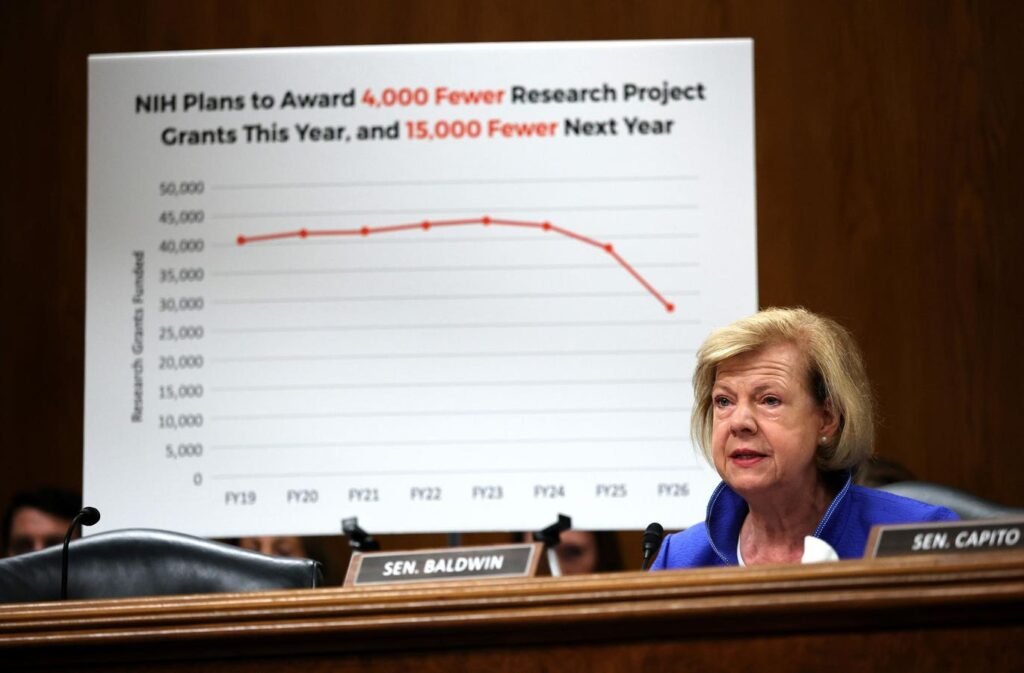U.S. Sen. Tammy Baldwin (D-WI) sits in front of a graph that shows how the National Institutes of Health (NIH) will be funding a lot fewer grants this year and next during her questioning of NIH director Jayanta Bhattacharya. (Photo by Win McNamee/Getty Images)
Getty Images
If you were informed that you had to perform hard work with about a one-in-ten chance of getting paid, would you accept it? Well, this used to be the reality for scientific researchers in the U.S. for years when applying for National Institute of Health (NIH) grants. However, the situation has worsened this year.
Before U.S. President Donald Trump’s second term began in January, scientific researchers relied on NIH grants to support themselves and their teams. However, the Trump Administration has made it even more challenging for scientists to secure these grants, affecting their ability to sustain their work, support their families, and contribute to scientific advancements.
How The New Multiyear NIH Funding Policy Works
One significant change introduced by the Trump Administration is the implementation of a multiyear funding policy for NIH grants, leading to a drastic decrease in funding rates for grants, particularly affecting research on cancer prevention and treatment.
Previously, each NIH institute would allocate grants based on its annual budget. However, under the new policy, institutes must have the full funding amount available for the entire grant duration upfront. This change has severely limited the number of grants awarded, impacting the progression of vital scientific research.
The implementation of this policy has not only reduced grant opportunities but has also been carried out without proper consultation with Congress, scientists, or the public. This lack of transparency and input threatens the integrity of scientific research and the well-being of society as a whole.
The Problems With The NIH Multiyear Funding Policy
The shift to a multiyear funding policy for NIH grants poses significant challenges for researchers and institutions. By requiring upfront funding for the entire grant duration, the policy restricts the number of grants awarded, hindering the progress of essential scientific projects.
This change deviates from standard practices in other sectors, where funding is typically allocated annually based on current budgets. The sudden shift to a multiyear funding model jeopardizes the future of scientific research and the development of innovative solutions to societal challenges.
The Multiyear Funding Policy Means Much Fewer NIH Grants Will Be Awarded
With the implementation of the multiyear funding policy, the number of NIH grants awarded has significantly decreased, impacting the scientific community’s ability to conduct essential research. The stringent funding requirements have led to a substantial reduction in grant opportunities, limiting scientific advancements and innovation.
This policy not only undermines the progress of scientific research but also reflects a broader trend of diminishing support for scientific endeavors. The implications of these funding cuts extend beyond the scientific community, affecting the economy, public health, and overall societal well-being.
NIH Funding Cuts Are Being Made Without The Approval Of Scientists, Congress Or The Many Patients Affected
The unilateral decision to implement funding cuts without proper consultation or approval from key stakeholders raises concerns about the future of scientific research and innovation. By neglecting input from scientists, Congress, and the public, the Trump Administration’s actions threaten the integrity of the scientific process and jeopardize the progress of critical research projects.
It is essential to address these challenges and advocate for transparent and inclusive decision-making processes to ensure the continued advancement of science and the well-being of society as a whole.
Why What’s Happening At The NIH Affects Everyone
The impact of the funding cuts at the NIH extends far beyond the scientific community, affecting individuals, institutions, and industries across the country. The reduction in grant opportunities jeopardizes the future of scientific research and innovation, with far-reaching consequences for public health and societal well-being.
As funding for NIH grants continues to decline, it is crucial to recognize the broader implications of these cuts and advocate for policies that support scientific research and progress. By prioritizing scientific advancement and innovation, we can ensure a brighter and healthier future for all.


